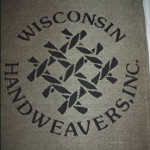 Sara learned to weave while living in Germany for 20 years. She is largely self-taught through books, lessons, observation of professional weavers, and extensive museum visits and connections (Textilmuseum Neumunster/Klaus Tidow, Freilichtmuseum [Open Air Museum], and Schleswig-Holstein in Kiel/Molfsee/Dr. Karl-Ingwer Johansson). She has always been interested in textile history and archaeology. Sara founded a group that shares weaving and weaving history with the public at Freilichtmuseum Kiel, and “descendants” of that group still work there. She has also studied drawloom weaving with Joanne Hall, Oaxacan rug weaving with Wence Martinez, Navajo weaving techniques with Sarah Natani and Mary Walker, Jacquard weaving at Oriole Mill with Bethanne Knudsen, and courses in Jacquard design at Eastern Michigan University. She weaves on countermarche looms, a 16-shaft computer-assisted dobby, a 50-pattern-shaft drawloom with eight ground shafts, and Jacquard looms. Her woven work centers on household linens and rugs, decorative items from the drawloom, and clothing fabrics and scarves. Sara is a member of the Wisconsin Handweavers, Complex Weavers, and European Damask Network. Sara owns a full service fiber shop, The Woolgatherers Ltd. in Fond du Lac, WI. she gives individual instruction in basic, intermediate and advanced weaving, and teaches at conferences (Convergence, CW Seminars) and guilds.
Sara learned to weave while living in Germany for 20 years. She is largely self-taught through books, lessons, observation of professional weavers, and extensive museum visits and connections (Textilmuseum Neumunster/Klaus Tidow, Freilichtmuseum [Open Air Museum], and Schleswig-Holstein in Kiel/Molfsee/Dr. Karl-Ingwer Johansson). She has always been interested in textile history and archaeology. Sara founded a group that shares weaving and weaving history with the public at Freilichtmuseum Kiel, and “descendants” of that group still work there. She has also studied drawloom weaving with Joanne Hall, Oaxacan rug weaving with Wence Martinez, Navajo weaving techniques with Sarah Natani and Mary Walker, Jacquard weaving at Oriole Mill with Bethanne Knudsen, and courses in Jacquard design at Eastern Michigan University. She weaves on countermarche looms, a 16-shaft computer-assisted dobby, a 50-pattern-shaft drawloom with eight ground shafts, and Jacquard looms. Her woven work centers on household linens and rugs, decorative items from the drawloom, and clothing fabrics and scarves. Sara is a member of the Wisconsin Handweavers, Complex Weavers, and European Damask Network. Sara owns a full service fiber shop, The Woolgatherers Ltd. in Fond du Lac, WI. she gives individual instruction in basic, intermediate and advanced weaving, and teaches at conferences (Convergence, CW Seminars) and guilds.
Experimenting with Aspect Ratio (Adjusting Proportions in Woven Fabric)
501, Sunday AM

 How does one “square” or “squash” or “elongate” a charted design to have pleasing proportions after weaving and wet-finishing? The design grid is usually done in squares, yet thread on the loom, in spite of careful planning, does not always produce that square when the threads intersect. It is not always possible to use warp and weft yarns of perfect proportions. Many woven structures require more than a single pick and/or warp end to produce one square on the design grid (découpure). The structure of the yarn in terms of plies and twist can make a difference in how it packs on the loom. And not the least of the issues involved, finishing and/or wet-finishing off the loom can skew the proportions of the pattern design. This presentation will include several methods, for use with any fabric structure or loom model, to insure that a woven design is neither shortened or elongated beyond what is desired. We will look at proportion; what a pixel represents in the design grid; calculating take-up and shrinkage in relation to the design; yarn qualities (grist, spinning technique, fiber content); software simulation; and sampling and adjustments. Participants are welcome to bring samples, either successful or needing improvement.
How does one “square” or “squash” or “elongate” a charted design to have pleasing proportions after weaving and wet-finishing? The design grid is usually done in squares, yet thread on the loom, in spite of careful planning, does not always produce that square when the threads intersect. It is not always possible to use warp and weft yarns of perfect proportions. Many woven structures require more than a single pick and/or warp end to produce one square on the design grid (découpure). The structure of the yarn in terms of plies and twist can make a difference in how it packs on the loom. And not the least of the issues involved, finishing and/or wet-finishing off the loom can skew the proportions of the pattern design. This presentation will include several methods, for use with any fabric structure or loom model, to insure that a woven design is neither shortened or elongated beyond what is desired. We will look at proportion; what a pixel represents in the design grid; calculating take-up and shrinkage in relation to the design; yarn qualities (grist, spinning technique, fiber content); software simulation; and sampling and adjustments. Participants are welcome to bring samples, either successful or needing improvement.
